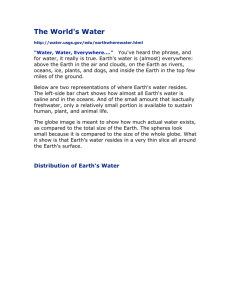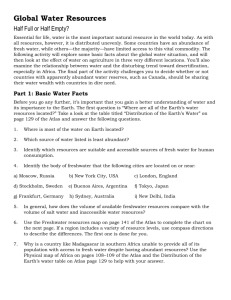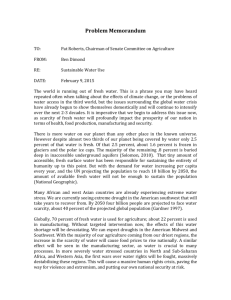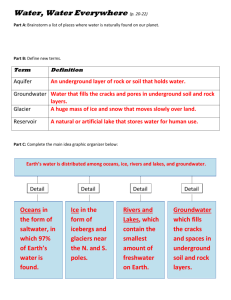Activity 2.1.1 Global Water Distribution
advertisement
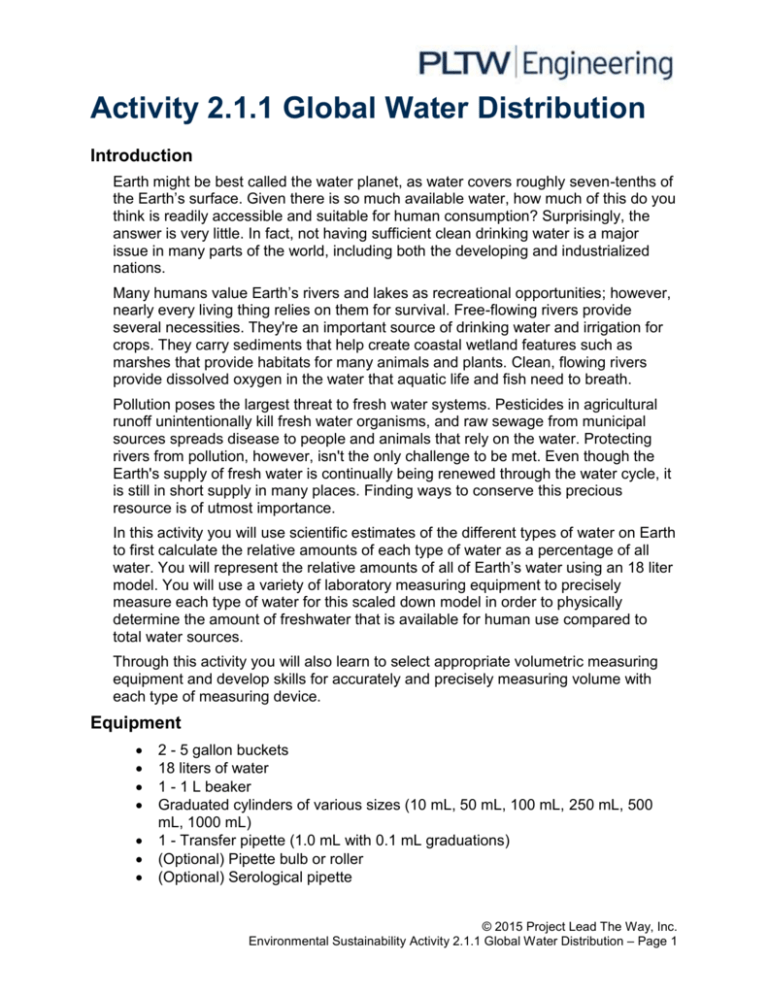
Activity 2.1.1 Global Water Distribution Introduction Earth might be best called the water planet, as water covers roughly seven-tenths of the Earth’s surface. Given there is so much available water, how much of this do you think is readily accessible and suitable for human consumption? Surprisingly, the answer is very little. In fact, not having sufficient clean drinking water is a major issue in many parts of the world, including both the developing and industrialized nations. Many humans value Earth’s rivers and lakes as recreational opportunities; however, nearly every living thing relies on them for survival. Free-flowing rivers provide several necessities. They're an important source of drinking water and irrigation for crops. They carry sediments that help create coastal wetland features such as marshes that provide habitats for many animals and plants. Clean, flowing rivers provide dissolved oxygen in the water that aquatic life and fish need to breath. Pollution poses the largest threat to fresh water systems. Pesticides in agricultural runoff unintentionally kill fresh water organisms, and raw sewage from municipal sources spreads disease to people and animals that rely on the water. Protecting rivers from pollution, however, isn't the only challenge to be met. Even though the Earth's supply of fresh water is continually being renewed through the water cycle, it is still in short supply in many places. Finding ways to conserve this precious resource is of utmost importance. In this activity you will use scientific estimates of the different types of water on Earth to first calculate the relative amounts of each type of water as a percentage of all water. You will represent the relative amounts of all of Earth’s water using an 18 liter model. You will use a variety of laboratory measuring equipment to precisely measure each type of water for this scaled down model in order to physically determine the amount of freshwater that is available for human use compared to total water sources. Through this activity you will also learn to select appropriate volumetric measuring equipment and develop skills for accurately and precisely measuring volume with each type of measuring device. Equipment 2 - 5 gallon buckets 18 liters of water 1 - 1 L beaker Graduated cylinders of various sizes (10 mL, 50 mL, 100 mL, 250 mL, 500 mL, 1000 mL) 1 - Transfer pipette (1.0 mL with 0.1 mL graduations) (Optional) Pipette bulb or roller (Optional) Serological pipette © 2015 Project Lead The Way, Inc. Environmental Sustainability Activity 2.1.1 Global Water Distribution – Page 1 1 - Micropipette (0.5 L –10 L) 1 - Micropipette (20 L – 200 L) Micropipette tips to fit micropipettes Calculators or computer with Excel® or other spreadsheet software Procedure In your engineering notebook, write down your best estimate without conducting any research of the percentage of all water on Earth that is suitable and available for human consumption. Look at all of the different sources of water shown on Table 1 below. Place a checkmark in the last column next to what you think are the three most common sources of human drinking water. Calculate Percentages and Proportions - These calculations can be done using a calculator and the chart on the next page or using the Excel spreadsheet 2.2.1.A Global Water Distribution Excel.xlsx. A. Using the data for each type and amount of water on Earth, calculate the total water percentage of each type of water source and record your calculations in Table 1. B. Calculate the percentage of each freshwater (non-saline) source compared to the total fresh water and record your calculations. C. For the scaled-down water model in which 18.00 liters (L) of water represents all of Earth’s water, calculate the proportional volume in milliliters (mL) for each type of water. Record these values in Table 1. Check to make sure that the sum of all these proportional calculations equals 18.00 L. D. Total the amount of water available for human consumption in the 18 L scale model and record this figure in your engineering notebook. Select Measuring Equipment A. View and take notes in your engineering notebook on the Measuring Volume presentation. B. Look at the volumes of water to be measured in 18 L scale model and determine which type of laboratory measuring tool, from the list of equipment available, should be used to most accurately and precisely measure that volume. Record your choice and reasoning in Table 1. Complete Activity 2.1.1 Using a Micropipette Student Resource © 2015 Project Lead The Way, Inc. Environmental Sustainability Activity 2.1.1 Global Water Distribution – Page 2 Table 1: Global Distribution of Water Water Source Water Volume (km3) Total Water (%) Fresh Water (%) 18 L Scale Model Proportional Volume (mL) Best Instrument for Measuring Volume √ if Common Source for Human Consumption Saline Water Oceans, Seas, and Bays Groundwater: Saline Lakes: Saline Total Saline Water 1,338,000,000 12,870,000 85,400 1,350,955,400 Freshwater Ice caps, Glaciers, and Permanent Snow Soil Moisture Ground Ice and Permafrost 24,064,000 16,500 300,000 Atmosphere 12,900 Swamp Water 11,470 Biological Water Groundwater: Fresh Rivers Lakes: Fresh Total Fresh Water Total Global Water 1,120 10,530,000 2,120 91,000 35,029,110 1,385,984,510 Data Source: Igor Shiklomanov's chapter "World fresh water resources" in Peter H. Gleick (editor), 1993, Water in Crisis: A Guide to the World's Fresh Water Resources (Oxford University Press, New York). http://ga.water.usgs.gov/edu/earthhowmuch.html © 2015 Project Lead The Way, Inc. Environmental Sustainability Activity 2.1.1 Global Water Distribution – Page 3 Measure Water Volumes for the 18 L Scale Model A. Measure 18.00 liters of water into one of your 5 gallon buckets using the measuring device that will provide the most accurate measurement for this volume of water. B. Using the proportional volume values that you calculated, use the volumetric device you indicated as most suitable for each measurement to accurately transfer that amount of water from the full bucket to the empty bucket. Start with the saline water sources and progressively move down through the freshwater sources. Stop transferring the water after completing the “Biological Water” measurement. C. The amount of water remaining in the starting bucket represents the percentage of all water out of all 18 L that is usable for human consumption. Measure the volume of this consumable water and record this measurement in your engineering notebook. D. [Optional] If teacher demonstrates Steps 5 A and B, then each student group will start with the same amount measured in step 5C to measure the amount of freshwater. [Optional] Use your Excel Spreadsheet data to create a chart to demonstrate the distribution of the Earth’s water. Conclusion How did the amount of water you measured in the last step of the procedure compare with the calculated sum of water available for human consumption (fresh groundwater, fresh lakes, and rivers)? Explain why there might be differences between the calculated volume and the actual measured volume. What are the potential sources of error in this activity? What could be done to minimize errors? It was very similar in proportions, but massively smaller in actual size. There might be differences in calculated volume and actual volume due to human error and inaccuracies in filling the tank. Explain how you chose the correct volumetric measuring instrument, such as a beaker, a graduated cylinder, a pipette, or a micropipette. I chose a graduated cylinder due to its superb capabilities of measuring liquids accurately. I also chose the graduated cylinder due to it having a larger capacity than the other available options. How did your choice of different volumetric measuring instruments potentially affect the accuracy and/or precision? My choice of volumetric measuring instruments made my measurements more accurate and reduced the chance of error. Considering the percentage of usable fresh water, what should we be concerned about when we use water? We should be concerned about how we use water to preserve the amount of drinkable water we have. This is because we have less than 2% of water on earth available to drink. Only less than 1% is accessible. © 2015 Project Lead The Way, Inc. Environmental Sustainability Activity 2.1.1 Global Water Distribution – Page 4 Describe at least three other factors that might make availability of fresh water for human consumption a challenge in different parts of the world. Location of water- It can make it difficult to obtain said water. Quality of water – Is it contaminated? Amount of water – Is there enough for everyone to drink © 2015 Project Lead The Way, Inc. Environmental Sustainability Activity 2.1.1 Global Water Distribution – Page 5

